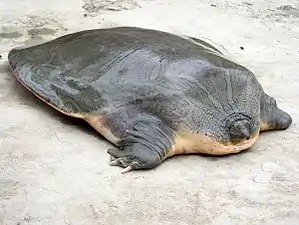Indian narrow-headed softshell turtle
Indian narrow-headed softshell turtle (Chitra indica) also known as small-headed softshell turtle[2] is an endangered species of softshell turtle found in rivers of the Indian Subcontinent. It is very large and feeds on fish, frogs, crustaceans and molluscs, which it ambushes.[3] In the past it was included in Chitra chitra; a species restricted to Southeast Asia using current taxonomy.[1]
| Indian narrow-headed softshell turtle | |
|---|---|
 | |
| Scientific classification | |
| Kingdom: | Animalia |
| Phylum: | Chordata |
| Class: | Reptilia |
| Order: | Testudines |
| Suborder: | Cryptodira |
| Family: | Trionychidae |
| Genus: | Chitra |
| Species: | C. indica |
| Binomial name | |
| Chitra indica (Gray, 1831) | |
| Synonyms[1] | |
| |
Diagnostic characters
This species is very large with a carapace up to 1.1 m (3.6 ft).[3]
- Overall color: olive to deep olive-green;
- Very complex midline (vertebral) carapacial pattern;
- Midline (vertebral) carapacial stripe present;
- Complex radiating costal stripes;
- Paramedian neck stripes forming a bell-like pattern on anterior carapace absent;
- Neck stripes do not form a continuous light rim around carapace;
- No distinct pair of neck stripes;
- Dark speckling on "light" (head and neck) stripes;
- Anterior neck "V" divergence point on neck;
- 3-4 forelimb lamellae;
- No peri-orbital X pattern;
- No distinct peri-orbital ocelli;
- No distinct naso-orbital triangular "figure";
- Few, if any, black dots present on chin pattern.
Type locality: "India, fl. Ganges, Penang"; restricted by Smith (1931:162) to "Fatehgarh, Ganges," India = "India: Ganges; Futtaghur" (Gray 1864: 92)
Distribution
This species is found in the Sutlaj and Indus river basins of the Islamic Republic of Pakistan, and Ganges, Godavari, Mahanadi and other rivers basins of India, Nepal and Bangladesh.[3] Although widespread, it occurs in low densities, even within protected areas.[3] It is threatened by hunting and habitat loss.[3] It prefers clear, large or medium rivers with sandy bottoms.[3] It spends most of time concealed below the sand, sometimes with only the tip of the nose exposed.[3]
Eating habits

Buried in sand, the Indian narrow-headed softshell turtle waits for its prey to come into its reach. When this happens, the turtle's head extends out of its shell at a high velocity in order to grab then eat the prey organism with its mouth.[4][5] In a 2009 video from Animal Planet's show River Monsters, this turtle is seen quickly extending its head and long retractable neck out of its shell.[6]
References
- Fritz Uwe; Peter Havaš (2007). "Checklist of Chelonians of the World" (PDF). Vertebrate Zoology. 57 (2): 312. ISSN 1864-5755. Archived from the original (PDF) on 1 May 2011. Retrieved 29 May 2012.
- Reptiles of Dudhwa tiger reserve... dudhwatigerreserve.com
- Das, I.; and Singh, S. (2009). Chitra indica. Conservation Biology of Freshwater Turtles and Tortoises, Chelonian Research Monographs 5
- "Chitra indica (Narrow-headed soft-shelled Turtle)".
- "Narrow-headed Softshell Turtle". Saint Louis Zoo.
- Animal Planet (24 April 2009). "River Monsters: Turtle Strikes Like a Snake". YouTube.
- Asian Turtle Trade Working Group (2000). "Chitra indica". IUCN Red List of Threatened Species. 2000: e.T4696A97399400. doi:10.2305/IUCN.UK.2000.RLTS.T4696A11088615.en.{{cite iucn}}: error: |doi= / |page= mismatch (help) Database entry includes a brief justification of why this species is endangered and the criteria used
- Boulenger, G.A. 1889 Catalogue of the Chelonians, Rhynchocephalians, and Crocodiles in the British Museum (Natural History). British Museum, London, 311 pp.
- Engstrom, Tag N., H. Bradley Shaffer, and William P. McCord. 2002 Phylogenetic Diversity of Endangered and Critically Endangered Southeast Asian Softshell Turtles (TrionychidaChitra). Biological Conservation 104 (2):173-179
- Gray, J. E. 1831 A synopsis of the species of Class Reptilia. In: Griffith, E & E. Pidgeon: The animal kingdom arranged in conformity with its organisation by the Baron Cuvier with additional descriptions of all the species hither named, and of many before noticed [Vol. 9]. Whittaker, Treacher and Co., London: 481 + 110 pp.
- Gray, J. E. 1831 Synopsis Reptilium or short descriptions of the species of reptiles. Part I: Cataphracta, tortoises, crocodiles, and enaliosaurians. Treuttel, Wurz & Co., London, 85 pp.
- Gray, J.E. 1844 Catalogue of Tortoises, Crocodilians, and Amphisbaenians in the Collection of the British Museum. British Museum (Natural History), London. viii + 80 p.
- Gray, J. E. 1864 Revision of the species of Trionychidae found in Asia and Africa, with descriptions of some new species. Proc. Zool. Soc. London 1864: 76-98
- Webb, R.G. 1980 Gray, Hardwicke, Buchanan-Hamilton, and drawings of Indian softshell turtles (Family Trionychidae). Amphibia-Reptilia 1: 61-74.

